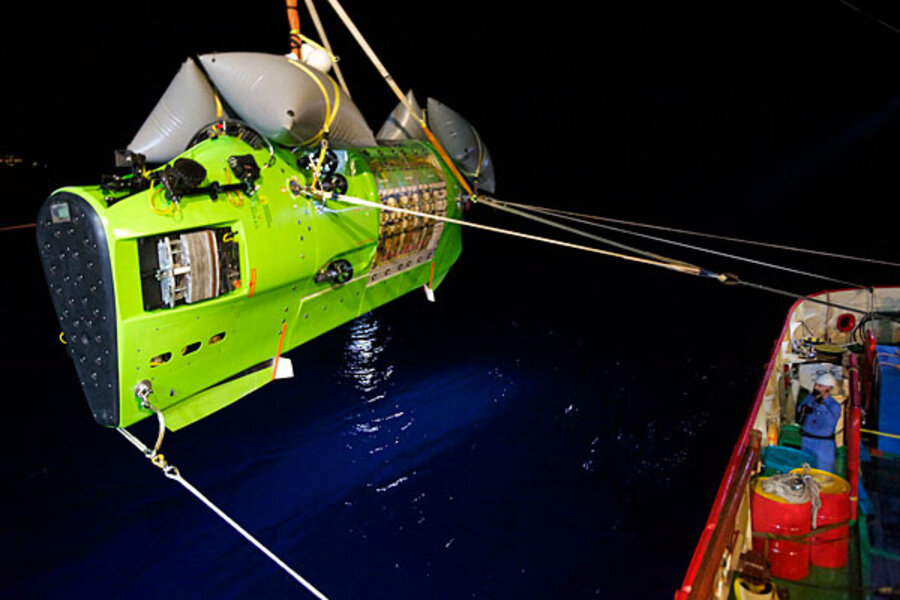What James Cameron saw 6.8 miles deep in Mariana Trench
Loading...
Returning from humankind's first solo dive to the deepest spot in the ocean, filmmaker James Cameron said he saw no obvious signs of life that might inspire creatures in his next "Avatar" movie but was awestruck by the "complete isolation."
The Oscar-winning director and undersea explorer said his record-setting expedition to the bottom of the Mariana Trench, 7 miles beneath the surface of the western Pacific, not only capped seven years of painstaking preparation but was the "culmination of a lifelong dream."
Cameron, 57, spoke to reporters in a telephone conference call from a yacht en route back to shore from the dive site hours after returning safely to the surface from his voyage to the floor of the immense undersea canyon at a point some 300 miles (480 miles) southwest of the U.S. Pacific territory of Guam.
RECOMMENDED: Are you scientifically literate? Take the quiz
He described a flat, desolate landscape, 50 times larger than the Grand Canyon, "devoid of sunlight, devoid of any heat, any warmth," where the pressure was so great that it squeezed the height of his submersible vehicle by several inches.
He looked out on the sea floor, illuminated by the lights on his submarine, through a small window.
"When I got to the bottom ... it was completely featureless and uniform," he said. "My feeling was one of complete isolation from all of humanity. ... More than anything, (it's) realizing how tiny you are down in this big, vast, black, unknown and unexplored place."
The only free-swimming creatures he saw near the bottom were tiny shrimp-like arthropods, but little else in the way of life was immediately visible. Cameronsaid further exploration would be required to discern what other organisms might dwell there.
Asked if he encountered anything he might use in his next feature film, he replied, "I can't answer that question right now." But he said, "Anything that I've ever seen underwater goes into the hopper of imagination that gets refracted out into the things that I write."
He also recounted the discomfort of his seven-hour journey into the ocean depths and back, wedged into a cramped, cold capsule at the bottom of a specially designed vehicle that stands 24 feet tall and descends upright and rotating at the speed of about 500 feet per minute.
The craft functioned flawlessly, he said, except for an unexplained failure of the hydraulic system that idled the vehicle's robot arm and prevented Cameron from collecting most of the biological and geologic samples he had hoped to retrieve.
NOT GIVING UP MOVIES
Better known as the director of such blockbuster films as "Titanic," "Aliens" and "Avatar," Cameron made history on Monday as the first person to venture alone to the so-called Challenger Deep, the lowest-known point of the Earth's crust, nearly 36,000 feet beneath the ocean surface.
He also was the first individual to make that journey since 1960, when the only other explorers to reach the bottom of the Mariana Trench - U.S. Navy Lieutenant Don Walsh and the late Swiss oceanographer Jacques Piccard - spent 20 minutes there together in the submersible craft Trieste.
Cameron said he was inspired as a boy by the original feat of Piccard and Walsh - a mentor and part of his support team at the surface - and by the adventures of French undersea explorer Jacques Cousteau, to take up diving at age 16, even though he lived "in a small, landlocked village in rural Canada."
"Most people probably know me as a filmmaker, but really the ocean and the idea of exploration has been the stronger driver in my life," he said.
By his count, Cameron has made 72 ocean dives in various submersible crafts over the years, including 12 trips during the making of "Titanic" to the famed shipwreck in the North Atlantic.
Still, Cameron insisted he had no plans to give up his movie career, saying, "I'm going to be turning my attention to 'Avatar 2' and 'Avatar 3' as soon as I finish up with this expedition."
His venture to the Challenger Deep is being chronicled for a 3-D film set for theatrical release and for subsequent broadcast on the National Geographic Channel.
(Editing by Tim Gaynor and Peter Cooney)





